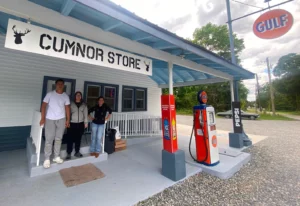 I’d like to send a warning to those cities that are looking at putting up a new venue for their local ball clubs: The era of “retro” parks could end soon. (Quite an upbeat theme for baseball’s Opening Day, eh?)
I’d like to send a warning to those cities that are looking at putting up a new venue for their local ball clubs: The era of “retro” parks could end soon. (Quite an upbeat theme for baseball’s Opening Day, eh?)
This also dovetails into a recent post on the the status of a ballpark in Richmond, Va., and the prospect of building a new one in a historical area known for its flooding. The need for a new baseball field, or at least a serious renovation, in Virginia’s capital has its merits: The old venue began crumbling, with chunks of concrete falling from the structure, about a decade after it opened. The clubhouses are considered tiny, the seats very uncomfortable and the concourses are dank.
But there’s a civic tragedy in all this. When the place, known as The Diamond, opened for the 1985 season, it was considered the best minor-league park in the United States. It also captured an all-too-rare moment in the old Confederate capital of cooperation between the primarily black City of Richmond and the majority-white counties in the suburbs.
Unfortunately, its sheen quickly dulled as the aesthetics of baseball changed. In 1988, the first proto-retro facility was built for the minor-league Buffalo Bisons and with the 1992 completion of the Baltimore’s Orioles Park at Camden Yards, the faux-antique park reached its full form, leaving The Diamond quickly obsolete as new stadia have sprouted across the United States ever since.
But now it’s over 20 years since the baseball began honoring its past with brick, steel and concrete. Mutterings have begun over the past six or seven years that the trend’s grown stale and flabby. Perhaps they’ll grow now that New York Times architecture critic Nicolai Ouroussoff criticized the movement as a “nostalgic funk” in his review of Citi Field and the new Yankee Stadium.
The Baby Boomers, who drove the nostalgia park wave by romanticizing the steel-and-girder baseball fields of their youth, will start dying soon. Could Generation Jones and Generation X, who grew up with the rather featureless multipurpose stadia, tire of this trend-only to have the next generation want retro-retro parks? Would Richmond, yet again, be holding the bag as it ends an architectural style for a park in what is effectively the city’s funnel during high rains?
There’s much to commend about the faux-nostalgia park, even if it often destroys real history for an “experience.” But it must be reinvented and utilize other forms of classic architecture such as one of the Modernist movements or-why not?-some Richardsonian Romanesque features.
Isotopes Park (see above) in Albuquerque utilizes some wonderfully funky mid-century features, and plans for a new ballpark in Tulsa emphasize the city’s history of Art Deco design. If Richmond and other cities embark on a steel and brick design, in 10 or 20 years, tastes will evolve.
And the taxpayers will suffer.







